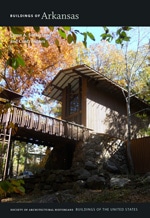Across Arkansas in the early decades of the twentieth century one-story white frame Colonial Revival houses like this one were popular for even moderately affluent citizens. Such houses offered an attractive image of genteel living, albeit on a modest scale. They are characterized by a hipped roof with transverse gables, a projecting gable section on the front, Colonial Revival decorative details, and a wraparound porch for a comfortable living space during the sultry summers. Situated on a corner lot and raised on a high brick foundation, the attractive details of the Butler house are seen to good advantage. A prominent framed oval leaded-glass window decorated the front gable, and leaded-glass panels appear over the front door and over the tripled windows in each gable. Supporting the porch are corner brick piers and Tuscan columns on brick plinths. On the interior, heavy cherry pocket doors could close off the two large front rooms from the foyer where Dr. Butler’s patients could wait before they were seen in the room on the left. Sometime in the 1920s the back porch, which contained a well, was enclosed to form a sleeping porch, a space that most Arkansans found indispensable before the advent of air-conditioning. Butler practiced medicine in Grant County from 1891 to his death in 1931. As was usually the case in a rich timber-producing locale, he was a “company doctor” for lumber mills, in addition to treating private patients.
You are here
John Lee Butler House
If SAH Archipedia has been useful to you, please consider supporting it.
SAH Archipedia tells the story of the United States through its buildings, landscapes, and cities. This freely available resource empowers the public with authoritative knowledge that deepens their understanding and appreciation of the built environment. But the Society of Architectural Historians, which created SAH Archipedia with University of Virginia Press, needs your support to maintain the high-caliber research, writing, photography, cartography, editing, design, and programming that make SAH Archipedia a trusted online resource available to all who value the history of place, heritage tourism, and learning.


